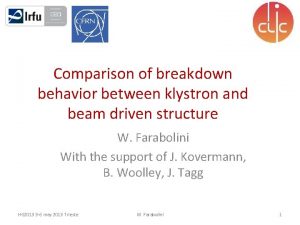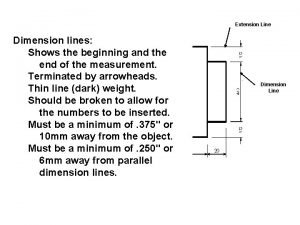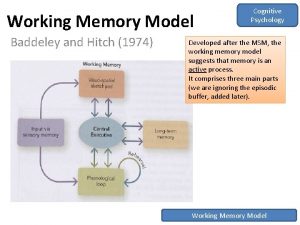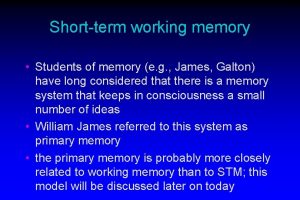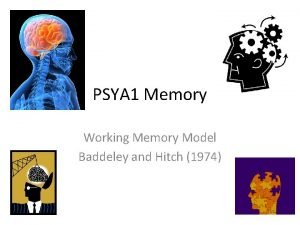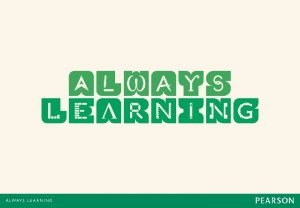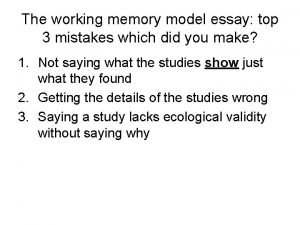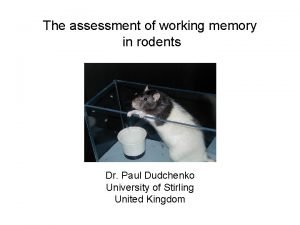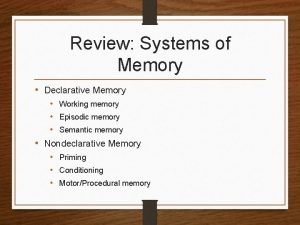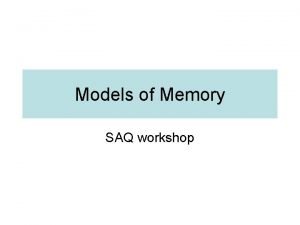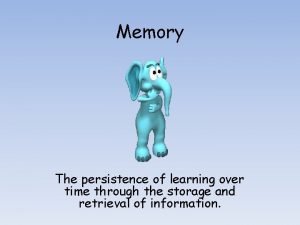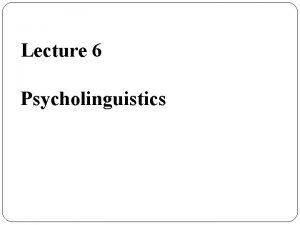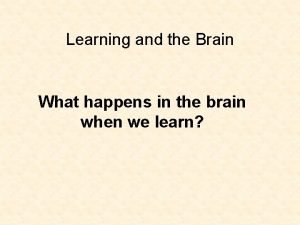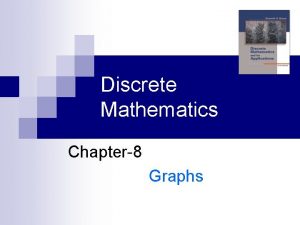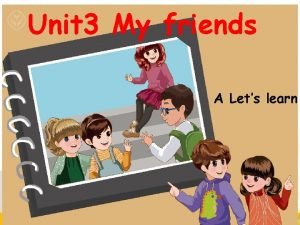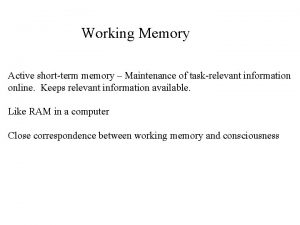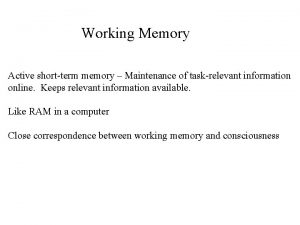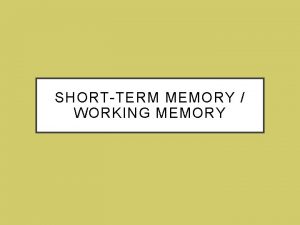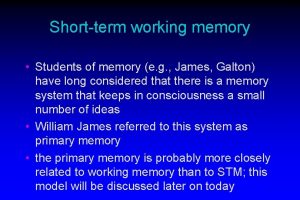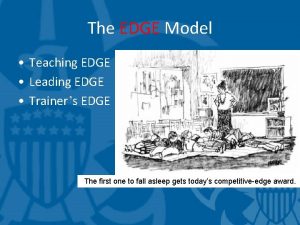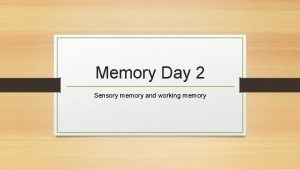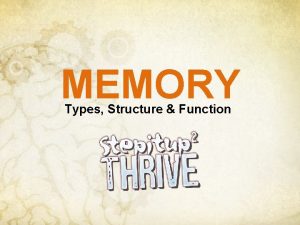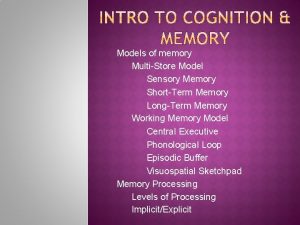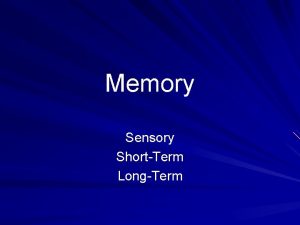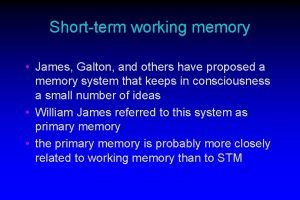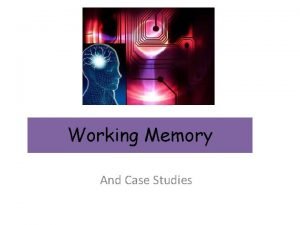ShortTerm and Working Memory The thin edge of








































































- Slides: 72

Short-Term and Working Memory


• The thin edge of the present is what is happening right at this moment, but a moment from now the present will become the past, and some of the past will become stored in memory. • What you will read in this chapter and the two that follow supports the idea that “everything in life is memory” and shows how our memory of the past not only provides a record of a lifetime of events we have experienced and knowledge we have learned, but can also affect our experience of what is happening right at this moment.

What Is Memory? • The defi nition of memory provides the fi rst indication of its importance in our lives: Memory is the processes involved in retaining, retrieving, and using information about stimuli, images, events, ideas, and skills after the original information is no longer present.

The Purposes of Memory • The fact that memory retains information that is no longer present means that we can use our memory as a “time machine” to go back just a moment —to the words you read at the beginning of this sentence—or many years —to events as early as a childhood birthday party. • This “mental time travel” afforded by memory can place you back in a situation, so you feel as though you are reliving it, even to the extent of experiencing feelings that were occurring long ago. But memory goes beyond reexperiencing events. • We also use memory to remember what we need to do later in the day, to remember facts we have learned, and to use skills we have acquired.

• If you were asked to create a “Top 10” list of what you use memory for, what would you include? When I ask my students to do this, most of their items relate to day-to-day activities. • The top five items on their list involved remembering the following things. • 1. Material for exams • 2. Their daily schedule • 3. Names • 4. Phone numbers • 5. Directions to places

• Remembering material for exams is probably high on most students’ lists, but it is likely that people from different walks of life, such as business executives, construction workers, homemakers, or politicians, would create lists that differ from the ones created by college students in ways that reflect the demands of their particular lives. • Remembering the material that will be on the next cognitive psychology exam would be an unlikely entry on a construction worker’s list, but remembering the procedure for framing a house might be on that list.

• One reason I ask students to create a “memory list” is to get them to think about how important memory is in their day-to-day lives. • But the main reason is to make them aware of how they don’t include many important functions on their lists, because they take them for granted. • A few of these things include labeling familiar objects (you know you are reading a “book” because of your past experience with books), having conversations (you need memory to keep track of the flow of a conversation), knowing what to do in a restaurant (you need to remember a sequence of events, starting with being seated and ending with paying the check), and finding your way to class.

• The list of things that depend on memory is an extremely long one because just about everything we do depends on remembering what we have experienced in the past. • But perhaps the most powerful way to demonstrate the importance of memory is to consider what happens to people’s lives when they lose their memory. Consider, for example, the case of Clive Wearing (Annenberg, 2000; D. Wearing, 2005). • Wearing was a highly respected musician and choral director in England who, in his 40 s, contracted viral encephalitis, which destroyed parts of his temporal lobe that are important forming new memories. • Because of his brain damage, Wearing lives totally within the most recent one or two minutes of his life. He remembers what just happened and forgets everything else. When he meets someone, and the person leaves the room and returns three minutes later, Wearing reacts as if he hadn’t met the person earlier. • Because of his inability to form new memories, he constantly feels he has just become conscious for the fi rst time

• This feeling is made poignantly clear by Wearing’s diary, which contains hundreds of entries like “I have woken up for the fi rst time” and “I am alive” (Figure 5. 1). • But Wearing has no memory of ever writing anything except for the sentence he has just written. • When questioned about previous entries, Wearing acknowledges that they are in his handwriting, but because he has no memory for writing them, he denies that they are his. It is no wonder that he is confused, and not surprising that he describes his life as being “like death. ” • His loss of memory has robbed him of his ability to participate in life in any meaningful way, and he needs to be constantly cared for by oth


• In this chapter we will begin describing the basic principles of memory so we can understand both cases like Clive Wearing’s and also the basic principles behind normal memory processes (Figure 5. 2). • We begin by describing a model of memory we introduced in Chapter 1 called the modal model (see p. 20). • After describing the modal model, we will focus on the short-term components of the model, first looking at properties of sensory memory and short-term memory and then at research that has led to a more modern way of looking at the short-term stage of memory, which is called working memory. • Finally, we will describe research on where some of the mechanisms of working memory are located in the brain.

The Modal Model of Memory • The modal model of memory, which was proposed by Richard Atkinson and Richard Shiffrin (1968), is shown in Figure 5. 3. • As we noted in Chapter 1, this model, which was proposed 40 years ago, is too simple to explain many of the things that have been discovered about memory since the model was proposed, but it does provide a way to introduce many of the basic principles of memory. • We will, therefore, use the modal model as our starting point, and will update the model later in this and subsequent chapters

• The stages of the modal model are called the structural features of the model. • There are three major structural features: • 1. Sensory memory is an initial stage that holds all incoming information for seconds or fractions of a second. • 2. Short-term memory (STM) holds 5– 7 items for about 15– 30 seconds. • We will be describing the characteristics of short-term memory in this chapter. • 3. Long-term memory (LTM) can hold a large amount of information for years or even decades. We will describe long-term memory in Chapters 6 and 7.


• Atkinson and Shiffrin also describe the memory system as including control processes, which are active processes that can be controlled by the person and may differ from one task to another. • An example of a control process is rehearsal—repeating a stimulus over and over, as you might repeat a telephone number in order to hold it in your mind after looking it up in the phone book. • Other examples of control processes are • (1) strategies you might use to help make a stimulus more memorable, such as relating the numbers in a phone number to a familiar date in history, and • (2) strategies of attention that help you selectively focus on other information you want to remember.

• To illustrate how the structural features and control processes operate, let’s consider what happens as Rachel looks up the number for Mineo’s Pizza in the phone book (Figure 5. 4). • When she first looks at the book, all of the information that enters her eyes is registered in sensory memory (Figure 5. 4 a). • But Rachel focuses on the number for Mineo’s using the control process of selective attention, so the number enters STM (Figure 5. 4 b), and Rachel uses the control process of rehearsal to keep it there (Figure 5. 4 c). • After Rachel has dialed the phone number, she may forget it because it has not been transferred into long-term memory. However, she decides to memorize the number so next time she won’t have to look it up in the phone book.

• The process she uses to memorize the number, a control process we will discuss in Chapter 6, transfers the number into long-term memory, where it is stored (Figure 5. 4 d). • A few days later, when Rachel’s urge for pizza returns, she remembers the number. This process of remembering information that is stored in longterm memory is called retrieval because the information must be retrieved from LTM so it can reenter STM to be used (Figure 5. 4 e). • One thing that becomes apparent from our example is that the components of memory do not act in isolation. Long-term memory is essential for storing information, but before we can become aware of this stored information, it must be moved back into STM. • We will now consider each component of the model, beginning with sensory memory


Sensory Memory • Sensory memory is the retention, for brief periods of time, of the effects of sensory stimulation. • We can demonstrate this brief retention for the effects of visual stimulation with two familiar examples: the trail left by a moving sparkler and the experience of seeing a film. • The Sparkler’s Trail and the Projector’s Shutter It is dark, sometime around the Fourth of July, and you place a match to the tip of a sparkler. As sparks begin radiating from the hot spot at the tip, you sweep the sparkler through the air, and create a trail of light (Figure 5. 5). • Although it appears that this trail is created by light left by the sparkler as you wave it through the air, there is, in fact, no light along this trail.


• The lighted trail is a creation of your mind, which retains a perception of the sparkler’s light for a fraction of a second. • This retention of the perception of light in your mind is called the persistence of vision. Something similar happens while you are watching a fi lm in a darkened movie theater. You may see actions moving smoothly across the screen, but what is actually projected is quite different. • We can appreciate what is happening on the screen by considering the sequence of events that occur as a fi lm is projected. First, a single fi lm frame is positioned in front of the projector lens, and when the projector’s shutter opens, the image on the fi lm frame is projected onto the screen. • The shutter then closes, so the fi lm can move to the next frame without causing a blurred image, and during that time, the screen is dark. When the next frame has arrived in front of the lens, the shutter opens again, flashing the next image onto the screen. This process is repeated rapidly, 24 times per second, so 24 still images are flashed on the screen every second, with each image separated by a brief period of darkness (see Table 5. 1)


• A person viewing the fi lm sees the progression of still images as movement and doesn’t see the dark intervals between the images because the persistence of vision fills in the darkness by retaining the image of the previous frame. • If the period between the images is too long, the mind can’t fill in the darkness completely, and you perceive a flickering effect. • This is what happened in the early movies when the projectors flashed images more slowly, causing longer dark intervals. This is why these early films were called “flickers, ” a term that remains today, when we talk about going to the “flicks. ”

Sperling’s Experiment: Measuring the Visual Icon • The persistence of vision effect that adds a trail to our perception of moving sparklers and fi lls in the dark spaces between frames in a fi lm has been known since the early days of psychology (Boring, 1942). • This lingering of the visual stimulus in our mind was studied by Sperling (1960) in a famous experiment in which he fl ashed an array of letters, like the one in Figure 5. 6 a, on the screen for 50 milliseconds (ms; 50/1, 000 second) and asked his participants to report as many of the letters as possible. • This part of th. E experiment used the whole report method because participants were asked to report as many letters as possible from the whole matrix. When they did this they were able to report an average of 4. 5 out of the 12 letters.


• At this point Sperling could have concluded that because the exposure was brief, participants saw only an average of 4. 5 of the 12 letters. However, there is another possibility: • Perhaps participants saw most of the letters immediately after they were presented, but their perception faded rapidly as they were reporting the letters, so by the time they had reported 4– 5 letters, they could no longer see the matrix or remember what had been there. • Sperling devised the partial report method to determine which of these two possibilities is correct. • In this technique, he flashed the matrix for 50 ms, as before, but immediately after it was flashed, he sounded one of the following cue tones, to indicate which row of letters the participants were to report (Figure 5. 6 b): • High-pitched: Top row • Medium-pitched: Middle row • Low-pitched: Bottom ro. W

• Note that because the tones were presented after the letters were turned off, the participant’s attention was directed not to the actual letters, which were no longer present, but to whatever trace remained in the participant’s mind after the letters were turned off. • When the cue tones directed participants to focus their attention onto one of the rows, they correctly reported an average of about 3. 3 of the 4 letters (82 percent) in that row. • Because participants saw an average of 82 percent of the letters no matter which row was cued, Sperling concluded that the correct description of what was happening was that immediately after the display was presented, participants saw an average of 82 percent of the letters in the whole display, but were not able to report all of these letters because they rapidly faded as the initial letters were being reported.

• Sperling then did an additional experiment to determine the time course of this fading. For this experiment, Sperling devised a delayed partial report method in which the presentation of cue tones was delayed for a fraction of a second after the letters were extinguished (Figure 5. 6 c). • The result of the delayed partial report experiments was that when the cue tones were delayed for about half a second after the fl ash, participants were able to report only slightly more than 1 letter in a row, or a total of about 4 letters for all three rows—the same number of letters they reported using the whole-report technique. • Figure 5. 7 plots this result in terms of the number of letters available to the participants from the entire display, as a function of time following presentation of the display. This graph indicates that immediately after a stimulus is presented, all or most of the stimulus is available for perception. • This is sensory memory. Then, over the next second, sensory memory fades, until by 1 second, less than 5 of the 12 letters in the matrix can be reported. Note that this corresponds to the number of letters that were reported in the whole report technique.

• Sperling concluded from these results that a short-lived sensory memory registers all or most of the information that hits our visual receptors but that this information decays within less than a second. • This brief sensory memory for visual stimuli is called iconic memory or the visual icon (icon means “image”), and corresponds to the sensory memory stage of Atkinson and Shiffrin’s model. • Other research, using auditory stimuli, has shown that sounds also persist in the mind. This persistence of sound, which is called echoic memory, lasts for a few seconds after presentation of the original stimulus (Darwin et al. , 1972).

• Thus, sensory memory can register huge amounts of information (perhaps all of the information that reaches the receptors), but it retains this information for only seconds or fractions of a second. • There has been some debate regarding the purpose of this large but rapidly fading store (Haber, 1983), but many cognitive psychologists believe that the sensory store is important for • (1) collecting information to be processed; • (2) holding the information briefly while initial processing is going on; and • (3) filling in the blanks when stimulation is intermittent. • Sperling’s experiment is important not only because it reveals the capacity of sensory memory (large) and its duration (brief), but also because it provides yet another demonstration of how clever experimentation can reveal extremely rapid cognitive processes that we are usually unaware of. • (See the discussion of illusory conjunctions in Chapter 3, page 67, for another example of how cognitive psychologists studied a rapid process that occurs without our awareness. )


Short-Term Memory • Whatever you are thinking about right now, or remember from what you have just read, is in your short-term memory. • As we will see shortly, most of this information is eventually lost, with only some of it reaching the more permanent store of long-term memory. • Because of the brief duration of STM, it is easy to downplay its importance compared to LTM. • In my class survey of the uses of memory, my students focused almost entirely on how memory enables us to hold information for long periods,

• such as remembering directions, people’s names, or material that might appear on an exam • Certainly, our ability to store information for long periods is important, as attested by cases such as Clive Wearing’s, whose inability to form LTMs makes it impossible for him to function independently. But, as we will see, STM (and working memory, which we will describe later) is also crucial for normal functioning. • Consider, for example, the following sentence. The human brain is involved in everything we know about the important things in life, like music and dancing. How do we understand this sentence? • First, the beginning of the sentence is stored in STM. We then read the rest of the sentence and determine the overall meaning by comparing the information at the end of the sentence to the information at the beginning.

• But what if we couldn’t hold the beginning of the sentence in STM? If the information in the fi rst phrase faded before you completed the sentence, you might think that the topic of the sentence is music and dancing and wouldn’t realize that the sentence is really about the brain. • Holding small amounts of information for brief periods is the basis of a great deal of our mental life. Everything we think about or know at a particular moment in time involves STM because short-term memory is our window on the present. • (Remember from Figure 5. 4 e that Rachel became aware of the pizzeria’s phone number by transferring it from LTM to STM. ) • Early research on STM focused on answering the following two questions: • (1) What is the duration of STM? And • (2) How much information can STM hold

What Is the Duration of Short-Term Memory? • John Brown (1958) in England Lloyd Peterson and Margaret Peterson (1959) in the United States carried out experiments to determine the duration of STM. In their experiments participants were given a task similar to the one in the following demonstration. • Demonstration Remembering Three Letters • You will need another person to serve as a participant in this experiment. Tell the person that you are going to read three letters followed by a number. Once the person hears the number he or she should start counting backward by 3’s from that number, and then when you say “Recall, ” the person should write down the three letters heard at the beginning. • Once the person starts counting, time 20 seconds and say, “Recall. ” Note the accuracy and repeat this procedure for a few more trials, using a new set of letters and a new three-digit number on each trial.

• Peterson and Peterson found that their participants were able to remember about 80 percent of the letters after a 3 -second delay (left bar in Figure 5. 8 a), but could remember an average of only 10 percent of the three-letter groups after an 18 -second delay (right bar in Figure 5. 8 a). • Peterson and Peterson initially interpreted this result as demonstrating that participants forgot the letters because their memory trace decayed during the 18 seconds. • However, when G. Keppel and Benton Underwood (1962) looked closely at Peterson and Peterson’s results, they found that if they considered the participants’ performance on just the first trial, there is little falloff between the 3 -second and the 18 -second delay (Figure 5. 8 b). • However, when they analyzed the results for the third trial, they began seeing a drop-off in performance between the 3 -second and the 18 -second delay (Figure 5. 8 c).


• Why would memory become worse after a few trials? Keppel and Underwood suggested that the drop-off in memory was due not to decay of the memory trace, as Peterson and Peterson had proposed, but to proactive interference • (PI)—interference that occurs when information that was learned previously interferes with learning new information. • The effect of proactive interference is illustrated by what might happen when a frequently used phone number is changed. Consider, for example, what might happen when Rachel calls the number she had memorized for Mineo’s Pizza, 5215100, only to get a recording saying that the phone number has been changed to 522 -4100. • Although Rachel tries to remember the new number, she makes mistakes at fi rst because proactive interference is causing her memory for the old number to interfere with her memory for the new number. The fact that the new number is similar to the old one adds to the interference and makes it harder to remember the new number.

• What does it mean that the reason for the decrease in memory is proactive interference, rather than decay? From the point of view of understanding the basic mechanisms underlying memory, it is important to know that interference is a basic mechanism of forgetting. • From the point of view of our everyday life experience, it is easy to see that interference is happening constantly, as one event follows the next (and even when nothing is “happening, ” we are usually thinking about something). • The outcome of this constant interference is that the effective duration of STM, when rehearsal is prevented, is about 15– 20 seconds.

What Is the Capacity of Short-Term Memory? • Information is not only lost rapidly from STM, but there is a limit to how much information can be held there. One measure of this capacity is provided by the digit span— the number of digits a person can remember. • Digit Span You can determine your digit span by doing the following demonstration. • Demonstration Digit Span Using an index card or piece of paper, cover all of the numbers below. • Move the card down to uncover the first string of numbers. Read the numbers, cover them up, and then write them down in the correct order. Then move the card to the next string and repeat this procedure until you begin making errors. • The longest string you are able to reproduce without error is your digit span. • • 2149 39678 649784 7382015 84261432 482392807 5852981637

• If you succeeded in remembering the longest string of digits, you have a digit span of 10. • The typical span is between 5 and 8 digits. According to measurements of digit span, the capacity of STM is 5– 8 items. • But what exactly is an item? George Miller (1956) considered this question in a famous paper titled “The Magical Number Seven, Plus or Minus Two. ” Miller expanded the definition of an item beyond digits by considering how we remember words and combinations of words. • Consider, for example, trying to remember the following words: monkey, child, wildly, zoo, jumped, city, ringtail, young. How many units are there in this list? There are 8 words, but if we group them differently, they can form the following 4 pairs: ringtail monkey, jumped wildly, young child, city zoo. • We can take this one step further by arranging these groups of words into one sentence: The ringtail monkey jumped wildly for the young child at the city zoo

Chunking • Is the sentence about the child watching a monkey at the zoo 8 items, 4 items, or 1 item? Miller introduced the concept of chunking to describe the fact that small units (like words) can be combined into larger meaningful units, like phrases, or even larger units, like sentences, paragraphs, or stories. • A chunk has been defi ned as a collection of elements that are strongly associated with one another but are weakly associated with elements in other chunks (Gobet et al. , 2001). • In our example the word ringtail is strongly associated with the word monkey but is not as strongly associated with the other words, such as child or jumped.

• Research has shown that chunking in terms of meaning can increase our ability to hold information in STM. • Thus, we can recall a sequence of 5– 8 unrelated words, but arranging the words to form a meaningful sentence so that the words become more strongly associated with one another increases the memory span to 20 words or more (Butterworth et al. , 1990).

• K. Anders Ericcson and coworkers (1980) demonstrated an effect of chunking by showing how a college student with average memory ability was able to achieve amazing feats of memory. • Their participant, S. F. , was asked to repeat strings of random digits that were read to him. Although S. F. had a typical memory span of 7 digits, after extensive training (230 one-hour sessions), he was able to repeat sequences of up to 79 digits without error. • How did he do it? S. F. used chunking to recode the digits into larger units that formed meaningful sequences. For example, 3492 became “ 3 minutes and 49 point 2 seconds, near world-record mile time, ” and 893 became “ 89 point 3, very old man. ” • This example illustrates an interaction between STM and LTM, because S. F. , who was a runner, created some of his chunks based on his knowledge of running times that were stored in LTM.

• Another example of chunking that is based on an interaction between STM and LTM is provided by an experiment by William Chase and Herbert Simon (1973 a, 1973 b) in which they showed chess players pictures of chess pieces on a chessboard for 5 seconds. • The chess players were then asked to reproduce the positions they had seen. Chase and Simon compared the performance of a chess master who had played or studied chess for over 10, 000 hours to the performance of a beginner who had less than 100 hours of experience. • The results, shown in Figure 5. 9 a, show that the chess master placed 16 pieces out of 24 correctly on his fi rst try, compared to just 4 out of 24 for the beginner. • Moreover, the master required only four trials to reproduce all of the positions exactly, whereas even after seven trials the beginner was still making errors.

• We know that the master’s superior performance was caused by chunking because it occurred only when the chess pieces were arranged in positions from a real chess game. • When the pieces were arranged randomly, the chess master performed as poorly as the begin ner (Figure 5. 9 b). Chase and Simon concluded that the chess master’s advantage was due not to a more highly developed short-term memory, but to his ability to group the chess pieces into meaningful chunks. • Because the chess master had stored many of the patterns that occur in real chess games in LTM, he saw the layout of chess pieces not in terms of individual pieces but in terms of 4 to 6 chunks, each made up of a group of pieces that formed familiar, meaningful patterns. • When the pieces were arranged randomly, the familiar patterns were destroyed, and the chess master’s advantage vanished (also see De. Groot, 1965; Gobet et al. , 2001

• Chunking is an essential feature of STM because it expands the capacity of STM so it can handle 5– 8 chunks rather than just 5– 8 items. • This enables the limited-capacity STM to deal with the large amount of information involved in many of the tasks we perform every day, such as chunking letters into words as you read this, remembering the first three numbers of familiar telephone exchanges as a unit, and transforming long conversations into smaller units of meaning.


How Is Information Coded in Short-Term Memory • Coding refers to the way information is represented. Remember, for example, our discussion in Chapter 2 of how a person’s face can be represented by the pattern of fi ring of a number of neurons. Determining how a stimulus is represented by the fi ring of neurons is a physiological approach to coding. • We can also take a mental approach to coding by asking how a stimulus or an experience is represented in the mind. For example, imagine that you have just finished listening to your cognitive psychology professor give a lecture.

• We can describe different kinds of mental coding that occur for this experience by considering some of the ways you might remember what happened in class. • Remembering the sound of your professor’s voice is an example of auditory coding. Imagining what your professor looks like, perhaps by conjuring up an image in your mind, is an example of visual coding. Finally, remembering what your professor was talking about is an example of coding in terms of meaning, which is called semantic coding (see Table 5. 2).

Auditory Coding • One of the early experiments that investigated coding in STM was done by R. Conrad in 1964. In Conrad’s experiment, participants saw a number of target letters flashed briefly on a screen and were told to write down the letters in the order.

• they were presented. Conrad found that when participants made errors, they were most likely to misidentify the target letter as another letter that sounded like the target. • For example, “F” was most often misidentifi ed as “S” or “X, ” two letters that sound similar to “F. ” Thus, even though the participants saw the letters, the mistakes they made were based on the letters’ sounds. • From these results Conrad concluded that the code for STM is auditory (based on the sound of the stimulus), rather than visual (based on the visual appearance of the stimulus). • This conclusion fits with our common experience with telephone numbers. • Even though our contact with them in the phone book is visual, we usually remember them by repeating their sound over and over rather than by visualizing what the numbers look like in the phone book (also see Wickelgren, 1965).

Visual Coding • Some tasks, such as remembering the details of a diagram or an architectural fl oor plan, require visual codes (Kroll, 1970; Posner & Keele, 1967; Shepard & Metzler, 1971). • This use of visual codes in STM was demonstrated in an experiment by Guojun Zhang and Herbert Simon (1985), who presented Chinese language symbols to native-speaking Chinese participants. • The stimuli for this experiment were “radicals” and “characters” (Figure 5. 10 a). Radicals are symbols that are part of the Chinese language and that are not associated with any sound. Characters consist of a radical plus another symbol, and do have a sound.

• When participants were asked to reproduce a series of radicals presented one after another, or a series of characters, they were able to reproduce a string of 2. 7 radicals, on the average, and a string of 6. 4 characters, on average (Figure 5. 10 b). • The participants’ ability to remember the radicals must be due to visual coding because the radicals have no sound or meaning. • The participants’ superior memory for the characters is most likely due to the addition of auditory coding because each character is associated with a sound. Thus, both visual and auditory coding can be involved in STM


Semantic Coding • There is also evidence for semantic coding in STM. This is illustrated by an experiment by Delos Wickens and coworkers (1976). Table 5. 3 shows the experimental design for Wickens’ experiment. • He used three different groups of participants—a “professions” group, a “meat” group, and a “fruit” group. Participants in each group listened to three words (for example, banana, peach, apple for the fruit group), counted backward for 15 seconds, and then attempted to recall the three words. • They did this for a total of four trials, with different words presented on each trial.

• The basic idea behind this experiment was to fi rst create a decrease in memory for all three groups by starting Trials 2 and 3 with different words from the same category as was presented in Trial 1 (to cause proactive interference, which we discussed on page 147). • This result is shown in Figure 5. 11, which indicates that participants in all three groups remembered about 87 percent of the words on Trial 1 (Figure 5. 11 a), and the performance for all three groups dropped on Trials 2 and 3 (Figures 5. 11 b and c), so by Trial 3 they remembered only about 30 percent of the words

• The crucial trial in the experiment was Trial 4, because on this trial all three groups were presented with names of fruits. • From Figure 5. 11 d we can see that performance remained low for the fruit group because proactive interference continued for that group. But something different happened for the other two groups. • Performance increased for the meat group and the professions group because shifting to fruits eliminated the proactive interference that had built up on Trials 1– 3 for the names of meats and professions. • The resulting increase in performance is called release from proactive interference, or release from PI. • Figure 5. 11 d also indicates that the release from PI is not as pronounced for the switch from meats to fruits because meats and fruits are more similar to each other than are professions and fruits.

• What does release from PI tell us about coding in STM? The key to answering this question is to realize that the release from PI that occurs in the Wickens experiment depends on the words’ categories (fruits, meats, professions). • Because placing words into categories involves the meanings of the words, the results of the Wickens experiment demonstrate the operation of semantic coding in STM.



Working Memory: The Modern Approach to Short-Term Memory • In Chapter 1 we noted that models are used in cognitive psychology to organize data that has been generated in many experiments and also to pose questions to be answered by additional experiments. By these criteria, the modal model has been one of the most useful models in cognitive psychology, because it explains a great deal of data and has resulted in thousands of experiments. • But as happens with most models, new results emerge that can’t be easily explained by the model. This leads either to revision of the model or proposal of an entirely new one. • In the case of the short-term memory components of the modal model, new results prompted Alan Baddeley and Graham Hitch (1974) to propose that STM be replaced by working memory—a mechanism that consists of a number of specialized components. • One of the main results that led to the proposal of working memory was the observation that under some conditions participants could do two tasks at once. You can see this for yourself by doing the following demonstration.

Demonstration Reading Text and Remembering • Numbers Keep these numbers in your mind (7, 1, 4, 9) as you read the following passage. • Baddeley reasoned that if STM had a limited storage capacity of about the length of a telephone number, filling up the storage capacity should make it difficult to do other tasks that depend on STM. • But he found that participants could hold a short string of numbers in their memory while carrying out another task, such as reading or even solving a simple word problem. • How are you doing with this task? What are the numbers? What is the essence of what you have just read?

• Because Baddeley’s participants were able to read while simultaneously remembering numbers, he concluded that the shortterm process must consist of a number of components that can function separately. • In the demonstration, the digit span task in which you held numbers in your memory was handled by one component while comprehending the paragraph was handled by another component. • Based on results such as this, Baddeley decided the name of the short-term.

• process should be changed from short-term memory to working memory. Baddeley (2000 b) defines working memory as follows: Working memory is a limited-capacity system for temporary storage and manipulation of information for complex tasks such as comprehension, learning, and reasoning. • From this definition we can see that working memory differs from STM in two ways: • 1. Short-term memory is a single component, whereas working memory consists of a number of parts. • 2. Short-term memory is concerned mainly with holding information for a brief period of time, whereas working memory is concerned with the manipulation of information that occurs during complex cognition.

• Thus, working memory is concerned not just with how memory operates, but with how information is processed in the service of various forms of cognition, such as problem solving, thinking, attention, and language (Baddeley, 2000 b). • Working memory accomplishes the manipulation of information through the action of three components: the phonological loop, the visuospatial sketch pad, and the central executive (Figure 5. 12).


The phonological loop • The phonological loop holds verbal and auditory information. Thus, when you are trying to remember a telephone number or a person’s name, or to understand what your cognitive psychology professor is talking about, you are using your phonological loop (Figure 5. 13 a).

The visuospatial sketch pad holds visual and spatial information. When you form a picture in your mind or do tasks like solving a puzzle or finding your way around campus, you are using your visuospatial sketch pad (Figure 5. 13 b). • As you can see from the diagram, the phonological loop and the visuospatial sketch pad are attached to the central executive

• The central executive is where the major work of working memory occurs. The central executive pulls information from long-term memory and coordinates the activity of the phonological loop and visuospatial sketch pad by focusing on specific parts of a task and switching attention from one part to another. • One of the main jobs of the central executive is to decide how to divide attention between different tasks. • For example, imagine you are driving in a strange city, and a friend in the passenger seat is reading you directions to a restaurant while the news is being broadcast on the car radio.

• As your phonological loop takes in the verbal directions, your sketch pad is helping visualize a map of the streets leading to the restaurant (Figure 5. 14), and the central executive is coordinating and combining these two kinds of information. • In addition, the central executive might be helping you focus your attention on the directions and ignore the messages from the radio. • As we describe working memory, keep in mind that it is a hypothesis about how the mind works that needs to be tested by experiments. • A number of experiments have been conducted to illustrate how the phonological loop and visuospatial sketch pad work in different situations.
 Memory ki paribhasha
Memory ki paribhasha Shortterm housing
Shortterm housing Which memory is the actual working memory?
Which memory is the actual working memory? Rising edge and falling edge
Rising edge and falling edge Alphabet of lines
Alphabet of lines Hot working and cold working difference
Hot working and cold working difference Advantage of cold working
Advantage of cold working Machining operations
Machining operations Pembentukan plat pada pengerjaan panas
Pembentukan plat pada pengerjaan panas Smart vs hard working
Smart vs hard working Internal memory and external memory
Internal memory and external memory Primary memory and secondary memory
Primary memory and secondary memory Page fault
Page fault Working memory model
Working memory model Slave systems working memory model
Slave systems working memory model The working memory model diagram
The working memory model diagram Automated working memory assessment (awma)
Automated working memory assessment (awma) Working memory essay
Working memory essay Working memory
Working memory Working memory
Working memory Saq1
Saq1 What is the persistence of learning over time
What is the persistence of learning over time Working memory
Working memory Working memory
Working memory Isomorphism of graphs in discrete mathematics
Isomorphism of graphs in discrete mathematics Episodic memory
Episodic memory Implicit explicit memory
Implicit explicit memory Long term memory vs short term memory
Long term memory vs short term memory Logical versus physical address space
Logical versus physical address space Virtual memory in memory hierarchy consists of
Virtual memory in memory hierarchy consists of Eidetic memory vs iconic memory
Eidetic memory vs iconic memory Shared vs distributed memory
Shared vs distributed memory Who do i looklike
Who do i looklike Who are they
Who are they Hình ảnh bộ gõ cơ thể búng tay
Hình ảnh bộ gõ cơ thể búng tay Slidetodoc
Slidetodoc Bổ thể
Bổ thể Tỉ lệ cơ thể trẻ em
Tỉ lệ cơ thể trẻ em Voi kéo gỗ như thế nào
Voi kéo gỗ như thế nào Tư thế worm breton là gì
Tư thế worm breton là gì Alleluia hat len nguoi oi
Alleluia hat len nguoi oi Các môn thể thao bắt đầu bằng tiếng đua
Các môn thể thao bắt đầu bằng tiếng đua Thế nào là hệ số cao nhất
Thế nào là hệ số cao nhất Các châu lục và đại dương trên thế giới
Các châu lục và đại dương trên thế giới Công thức tính thế năng
Công thức tính thế năng Trời xanh đây là của chúng ta thể thơ
Trời xanh đây là của chúng ta thể thơ Cách giải mật thư tọa độ
Cách giải mật thư tọa độ Phép trừ bù
Phép trừ bù Phản ứng thế ankan
Phản ứng thế ankan Các châu lục và đại dương trên thế giới
Các châu lục và đại dương trên thế giới Thể thơ truyền thống
Thể thơ truyền thống Quá trình desamine hóa có thể tạo ra
Quá trình desamine hóa có thể tạo ra Một số thể thơ truyền thống
Một số thể thơ truyền thống Cái miệng nó xinh thế chỉ nói điều hay thôi
Cái miệng nó xinh thế chỉ nói điều hay thôi Vẽ hình chiếu vuông góc của vật thể sau
Vẽ hình chiếu vuông góc của vật thể sau Nguyên nhân của sự mỏi cơ sinh 8
Nguyên nhân của sự mỏi cơ sinh 8 đặc điểm cơ thể của người tối cổ
đặc điểm cơ thể của người tối cổ V cc
V cc Vẽ hình chiếu đứng bằng cạnh của vật thể
Vẽ hình chiếu đứng bằng cạnh của vật thể Tia chieu sa te
Tia chieu sa te Thẻ vin
Thẻ vin đại từ thay thế
đại từ thay thế điện thế nghỉ
điện thế nghỉ Tư thế ngồi viết
Tư thế ngồi viết Diễn thế sinh thái là
Diễn thế sinh thái là Dot
Dot Số nguyên là gì
Số nguyên là gì Tư thế ngồi viết
Tư thế ngồi viết Lời thề hippocrates
Lời thề hippocrates Thiếu nhi thế giới liên hoan
Thiếu nhi thế giới liên hoan ưu thế lai là gì
ưu thế lai là gì Khi nào hổ mẹ dạy hổ con săn mồi
Khi nào hổ mẹ dạy hổ con săn mồi Khi nào hổ con có thể sống độc lập
Khi nào hổ con có thể sống độc lập



